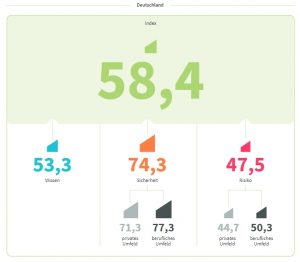
Survey by G DATA, brand eins and Statista shows: Phishing emails cause the greatest damage in the home office. Germany has some catching up to do when it comes to IT security knowledge. New magazine as a reference work: "Cybersecurity in numbers"
Screaming children, an unfamiliar work environment and poor office equipment: Working in the home office is not just pleasant for all employees. In this environment, people are much more susceptible to phishing than in the office, as a joint representative study by G DATA, brand eins and Statista shows. The magazine "Cybersecurity in Numbers" contains many more survey results and statistics.
Free magazine: cybersecurity in numbers
In the home office, phishing emails cause significantly more damage than in the private environment or in the office, as a current representative study with 5.000 respondents by G DATA, brand eins and Statista shows. In every fifth case in which employees in the home office fell victim to a phishing email, access data or personal data was diverted. In the office this was only 14,6 percent. Other damages included identity theft and financial loss.
"Since the beginning of the pandemic, we have warned that employees working from home are exposed to increased stress - and are therefore more susceptible to phishing emails," says Tim Berghoff, Security Evangelist at G DATA. "This study confirms our assumptions and makes the need for action clear."
Study proves the dangers in the home office
Even if the risk of phishing is highest in the home office, most of the emails arrive in the private accounts of the users. Across Germany, 31 percent of those surveyed stated this. The risk of fraudulent emails is also high in the office and at home. The study "Cybersecurity in Figures" makes it clear that the actual risk in the home office differs from region to region. In Bremen (14,3 percent), Berlin (13,9 percent) and Hamburg (11,9 percent), employees have the highest risk of receiving a phishing email in their home office.
These exclusive figures on the phishing risk in Germany are only a small glimpse into the magazine "Cybersicherheit in numbers" from G DATA, brand eins and Statista. In addition to a large-scale employee survey, the magazine summarizes the most important data on the status of cybersecurity.
New cybersecurity index
The new G DATA Cybersecurity Index is also part of the magazine. This makes it clear: A large part of the population values IT security highly. When assessing protective measures in the private and professional environment, the index is 74,3 points out of a maximum of 100. The downside of the coin: When it comes to knowledge of the topic and risk assessment, the values are significantly worse - knowledge: 53,3 points, risk: 47,5. This results in an overall index of 58,4. So there is still a lot of room for improvement.
Central results of the survey
The competence in IT security differs significantly depending on the industry in which the respondent's company is active:
- Sectors with a high level of competence: telecommunications and IT (64,6 percent), research and technology (57,3 percent) and the Internet (52,6 percent).
- Sectors with less competence: health and social affairs (24,3 percent), public service (27,2 percent), services (personnel, call centers) (28,8 percent).
There is still a lot of room for improvement when it comes to safety and protective measures
- Only 38,9 percent use secure, unique passwords; 28,9 percent use a paid antivirus program and only 44,4 percent regularly back up their data.
- The feeling of security is significantly higher in the professional environment than in the private sector. The assessment depends heavily on the competence of the respondents. For example, respondents with a very high level of competence rate IT security in the professional environment as very good with almost 58 percent. Only 35,5 percent of people with little competence rate the feeling of security as very good.
- When it comes to IT security, the following principle applies: Little effort and time and one solution for all devices. At the same time, the majority of respondents want to take care of device protection themselves (56,8 percent).
Current figures from the world of IT security
In addition to the survey, the magazine contains the most exciting figures on the topic of IT security and serves as a broad reference work on the topic of cybersecurity:
- The number of known vulnerabilities and vulnerabilities (CVE) has increased by 1999 percent since documentation began in 1.856.
- The rapid increase in ransom payments in Europe shows how great the cyber risk is. Last year alone, victims of ransomware attacks paid a ransom of 356,4 million euros in cryptocurrencies.
- Most of the cyber attacks in Germany are not displayed. The main reason for this: The lack of prospect of success in the investigation. 72 percent of those questioned expressed this opinion. In addition, there is a lack of knowledge of who is responsible for cyber attacks.
“The threat from cyberattacks is real. It's high time we started to take IT security seriously, ”says Susanne Risch, Editor-in-Chief, brand eins / Corporate Publishing. “The better we are familiar with the subject, the lower the dangers. Together with Statista and G DATA, we have therefore compiled figures, data and facts from all over the world and all areas of knowledge - and put together a full reading package that we will update every year from now on. Cybersecurity to be amazed, amazed and told. "
Background to the magazine
"Cybersecurity in numbers" is characterized by a high information density and particular methodological depth: As data specialists, the researchers and market researchers at Statista have brought together figures, data and facts from more than 300 statistics to a unique total value. More than 5.000 employees in Germany were questioned as part of a representative online study on cybersecurity in the professional and private context. The Statista experts closely followed the survey and, thanks to a sample size that is well above the industry standard, are able to present reliable and valid market research results in the “Cybersecurity in Figures” booklet.
More at GData.de
About G Data With comprehensive cyber defense services, the inventor of the anti-virus enables companies to defend themselves against cybercrime. Over 500 employees ensure the digital security of companies and users. Made in Germany: With over 30 years of expertise in malware analysis, G DATA conducts research and software development exclusively in Germany. The highest standards of data protection are paramount. In 2011, G DATA issued a “no backdoor” guarantee with the “IT Security Made in Germany” seal of trust from TeleTrust eV. G DATA offers a portfolio from anti-virus and endpoint protection to penetration tests and incident response to forensic analyzes, security status checks and cyber awareness training to defend companies effectively. New technologies such as DeepRay use artificial intelligence to protect against malware. Service and support are part of the G DATA campus in Bochum. G DATA solutions are available in 90 countries and have received numerous awards.


